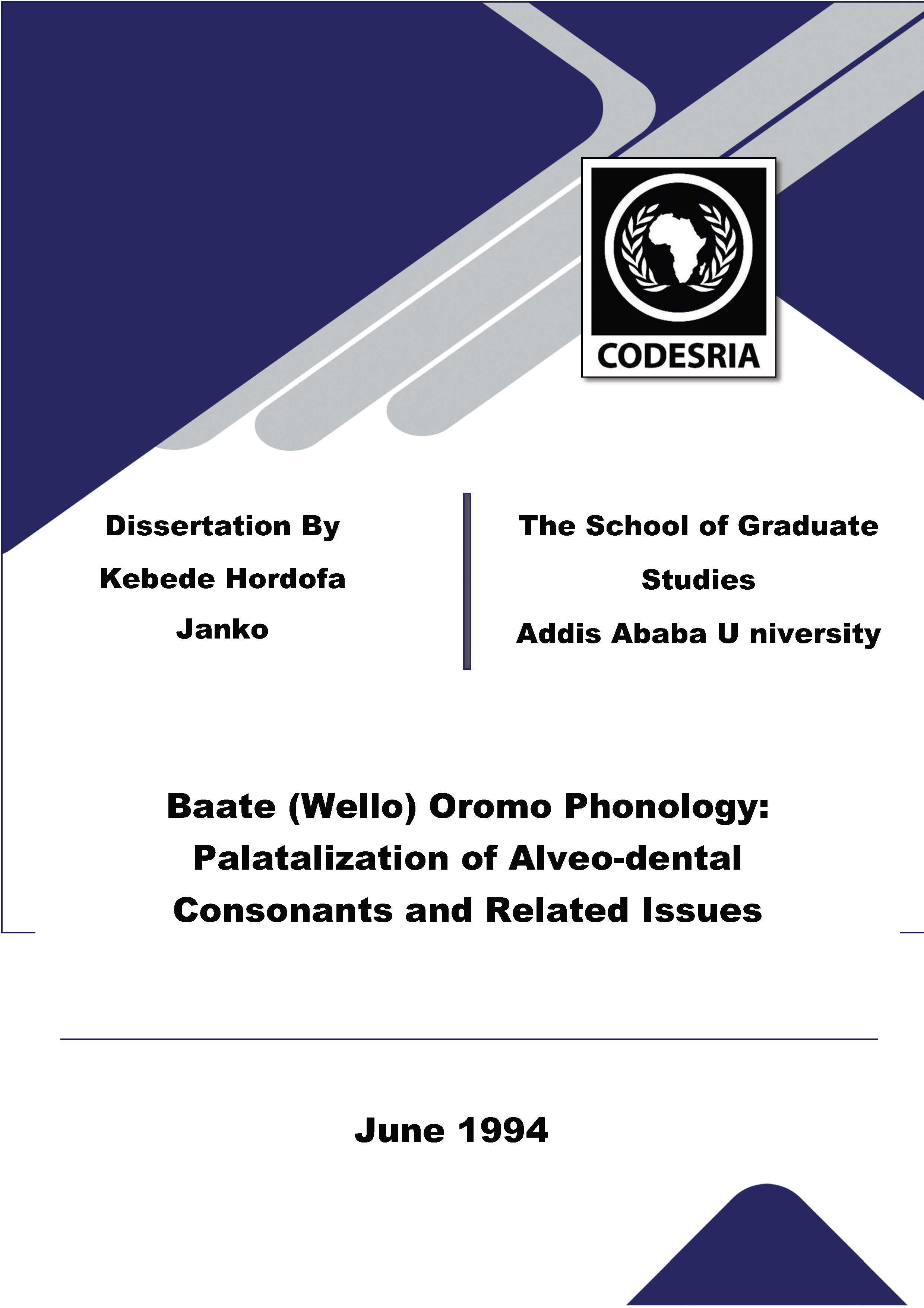Baate (Wello) Oromo Phonology: Palatalization of Alveo-dental Consonants and Related Issues
Mots-clés :
Baate, Oromo Phonology, Alveo-dental Consonants, PalatalizationSynopsis
Wello Oromo is one of the least described dialects of the Oromo language. The thesis describes the palatalization process of alveo-dental consonants in respect with Baate (officially "Baati") variety ofWello Oromo. Data were collected in two ways; by interviewing and by recording stories, conversations, etc.. The data are described in the framework of autosegmental phonology (see chapter 1.0). A descriptive overview of roots, stems and affixes that are relevant in the discussion of the palatalization process is also given (see chapter 2.0). The process which changes root-final semi-vowel y followed by nasal consonant !! to no is described in terms of recursive assimilatory process (see chapter 3.0). In previous work on Oromo, it is usually assumed that consonant ! begins the causative morpheme of Oromo. And this ! is thought to condition the palatalization of a preceding alveo-dental obstruent or lateral !- In this thesis, evidence is presented that the causative morpheme in Oromo begins with i and not with ! at underlying representation (see chapter 4.0). This assumption, could, therefore, well account for the palatalization of the alveo-dental obstruents and lateral ! (see chapter 5.0). In general it is established that consonants, !! , ! , g , ! , !' and ! are palatalized in the environment of an underlying high front vowel i or palatal semivowel y that may or may not directly appear on the surface. This is also in agreement with universal assumptions ab(?ut palatalization processes across languages. Also other related issues to the palatalization process are addressed in every chapter of the thesis. It is hoped that the study adds to our knowledge of Oromo and may also provide further material and analysis towards comparative study of Oromo dialectology which is currently not well understood.
Téléchargements
Références
Abebe G/Tsadiq, (No date), "Sidamo Morphophonological causatives and the Syntatic Roleof Direct Object". (an abstract of a paper presented to a seminar.) Akinlabi; Akinbiyi. (1993). "Underspecification and the Phonology of Yoruba/ri.Lingustic Inquiry. Vol 24, No. 1. pp. 139-160
Appleyard, L. David, (1986), "The Radical Extension System in Agew". In Proceedings of the Sixth International Conference ofEthiopian Studies. Tel. Aviv; pp. 1-23.
Archangeli;, Diana (1985) "Yokuts Harmony: Evidence for Coplanar Representation in Nonlinear Phonology" Linguistic Inquiry. Vol 16, No. 3, 1985 . pp. 335-372.
Anthony, Arlotto. (1972). Introduction to Historical Linguistics. Harvard University: University Press of America.
Béland, Renee, and Yves Favreau. (1991). "On the Speical Status of Coronals in Aphasia" In Paradis and Prunet (eds) (1991) pp. 201-22.
Bender, M.L (1976). The Non-Semitic Languages ofEthiopia (ed)., Monograph No. 5, Occassional Papers Series, Committee on Ethiopian Studies, East Lansing Carbondale, African Studies Center, Michigan State University.
Bhat, D.N.S. (1978) "A General Study of Palatalization" - In Joseph Greenberg, (ed), Universals of Human Language 2. pp. 47-92.
Black, P. (1974). "Lowland East Cushitic: Subgrouping and Reconstruction" -PH.D Dissertation, Yale University.
Bliese, Loren F. (1981). A Generative Grammar of Afar. A Publication of the Summer Institute of Linguistics and the University of Texas at Arlington.
Booij, Geerte. (1984) "Neutral Vowels and the Autosegmental Analysis ofHungarian Vowel Harmony".
Linguistics (1984). Vol. 22-5. pp. 629-41.
Chomsky, Noam, and Morris Halle (1968). The Sound Pattern ofEnglish. Newyork:Harper and Row.
Durand, Jaçques (1990). Generative and Nonlinear Phonology. London: Longman.






